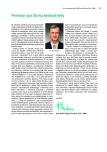Diabetes mellitus and pancreatic cancer – cause or result?
Authors:
Alena Šmahelová
Authors‘ workplace:
Diabetologické centrum, vedoucí doc. MUDr. Alena Šmahelová, III. interní gerontometabolická klinika LF UK a FN Hradec Králové, přednosta prof. MUDr. Luboš Sobotka, CSc.
Published in:
Vnitř Lék 2014; 60(9): 791-796
Category:
Overview
Incretin glucagon like peptid-1 receptor agonists are also known as incretin mimetics. These are the new drugs for the treatment of type 2 diabetes, which have a significant antihyperglycemic effect. For the individual treatment can be used short- acting and long-acting drugs. In addition to glucose effect there are influenced another factors, especially weight and hypertension. The patophysiological mechanism of their action, pharmacological and clinical differences and their use in clinical practice are described.
Key words:
glucagon-like peptid 1 – glucagon-like peptid 1 agonists short-acting/long-acting – clinical effects
Sources
1. Petrie JR. The cardiovascular safety of incretin-based therapies: a review of the evidence. Cardiovasc Diabetol 2013; 12: 130. Dostupné z DOI: <http://doi: 10.1186/1475–2840–12–130>.
2. Inzucchi SE, Bergenstal RM, Buse JB et al. Management of hyperglycemia in type 2 diabetes: a patient-centered approach position statement of the American Diabetes Association (ADA) and the European Association for the Study of Diabetes (EASD). Diabetes Care 2012; 35(6): 1364–1379.
3. Liebl A, Mata M, Eschwege E. Evaluation of risk factors for development of complications in type II diabetes in Europe. Diabetologia 2002; 45(7): S23-S28.
4. de Pablos-Velasco P, Bradley C, Eschwege E et al. The PANORAMA pan-European survey: glycaemic control and treatment patterns in patients with type 2 diabetes. Diabetologia 2010; 53(Suppl 1): Abstract 1012.
5. Viberti G, Kahn SE, Greene DA et al. A Diabetes outcome progression trial (ADOPT): an international multicenter study of the comparative efficacy of rosiglitazone, glyburide, and metformin in recently diagnosed type 2 diabetes. Diabetes Care 2002; 25(10): 1737–1743.
6. Nauck MA, Heimesaat MM, Behle Ket al. Effects of glucagon-like peptide 1 on counterregulatory hormone responses, cognitive functions, and insulin secretion during hyperinsulinemic, stepped hypoglycemic clamp experiments in healthy volunteers. J Clin Endocrinol Metab 2002; 87(3): 1239–1246.
7. Hansen L, Hartmann B, Bisgaard T et al. Somatostatin restrains the secretion of glucagon-like peptide 1 and 2 from isolated perfused porcine ileum. Am J Physiol Endocrinol Metab 2000; 278(6): E1010-E1018.
8. Meier JJ. GLP-1 receptor agonists for individualized treatment of type 2 diabetes mellitus. Nat Rev Endocrinol 2012; 8(12): 728–742.
9. Tschen SI, Dhawan S, Gurlo T et al. Age-dependent decline in β-cell proliferation restricts the capacity of β-cell regeneration in mice. Diabetes 2009; 58(6): 1312–1320.
10. Bunck MC, Cornér A, Eliasson B et al. Effects of exenatide on measures of β-cell function after 3 years in metformin-treated patients with type 2 diabetes. Diabetes Care 2011; 34(9): 2041–2047.
11. Nikolaidis LA1, Mankad S, Sokos GG et al. Effects of glucagon-like peptide 1 in patients with acute myocardial infarction and left ventricular dysfunction after successful reperfusion. Circulation 2004; 109(8): 962–965.
12. DeYoung MB, MacConell L, Sarin V et al. Encapsulation of exenatide in poly-(d,l-lactide-co-glycolide) microspheres produced an investigational long-acting once-weekly formulation for type 2 diabetes. Diabetes Technol Ther 2011; 13(11): 1145–1154.
13. Schwarz S. Evidence-Based Practice use of incretine based therapy in the natural history of diabetes. Postgrad Med 2014; 126(3): 66–84.
14. Gerich J. Pathogenesis and management of postprandial hyperglycemia: role of incretin-based therapies. Int J Gen Med 2013; 6: 877–95. Dostupné z DOI: <http://doi: 10.2147/IJGM.S51665>.
15. Vilsbøll T, Zdravkovic M, Le-Thi T et al. Liraglutide, a long-acting human glucagon-like peptide-1 analog, given as monotherapy significantly improves glycemic control and lowers body weight without risk of hypoglycemia in patients with type 2 diabetes. Diabetes Care 2007; 30(6): 1608–1610.
16. Garg R, Chen W, Pendergrass M. Acute pancreatitis in type 2 diabetes treated with exenatide or sitagliptin: a retrospective observational pharmacy claims analysis. Diabetes Care 2010; 33(11): 2349–2354.
17. Steinberg WM et al. Longitudinal monitoring of lipase and amylase in adults with type 2 diabetes and obesity: evidence from two phase 3 randomized clinical trials with the once-daily GLP-1 analog liraglutide [poster presentation at Digestive Disease Week 2012]. Gastroenterology 2012; 142(Suppl 1): S93-S91.
18. Butler PC, Matveyenko AV, Dry S et al. Glucagon-like peptide-1 therapy and the exocrine pancreas: innocent bystander or friendly fire? Diabetologia 2010; 53(1): 1–6.
19. Matveyenko AV, Dry S, Cox HI et al Beneficial endocrine but adverse exocrine effect of sitagliptin in the HIP rat model of type 2 diabetes, interactions with metformin. Diabetes 2009; 58(7): 1604–1615.
20. Informace dostupné z WWW: <http://www.ema.europa.eu/ema/index.jsp?curl=pages/news_and_events/news/2013/07/news_detail_001856.jsp&mid=WC0b01ac058004d5c1>.
21. Bjerre Knudsen L, Madsen LW, Andersen S et al. Glucagon-like peptide 1 receptor agonists activate rodent thyroid C cells causing calcitonin release and C cell proliferation. Endocrinology 2010; 151(4): 1473–1486.
22. Nauck MA, Friedrich N. Do GLP-1-Based Therapies Increase Cancer Risk? Diabetes Care 2013; 36(Suppl 2): S245-S252.
Labels
Diabetology Endocrinology Internal medicineArticle was published in
Internal Medicine

2014 Issue 9
Most read in this issue
- Life expectancy of people with type 1 diabetes in the past and today
- Gliptins: a safe and effective treatment of diabetes mellitus
- Insulin resistance – its causes and therapy possibilities
- AGEs and RAGE – advanced glycation end-products and their receptor in questions and answers
